The MGH invite you to join us on a trip through 200 years of medieval research history: The series “Treasures of the MGH Library and Archive” presents a treasure trove of rare and fascinating items illustrating key moments of our history. Enjoy discovering!
The „announcement of a complete edition of the best source-writers of the German history of the Middle Ages“ made public an idea that Heinrich Friedrich Karl Reichsfreiherr vom und zum Stein (1757-1831) had already been working on for a number of years. It was his long standing intent to found an association dedicated to the publication of mediaeval written sources, and to this purpose he commissioned Karl Georg Dümgé (1772-1845), an archive assessor from Baden, to write a concept for the project. In 1818, the concept was printed and published, declaring itself to be „an appeal to Germany’s scholars, an unpretentious draft of a plan to assess and correct the above mentioned shortcomings and, finally, a plea to receive the plan with sympathy.“
The Bavarian envoy to the German Bundestag in Frankfurt, Johann Adam Freiherr von Aretin, appraised the project with the following words: „The planned undertaking is so beautiful that every German who values the history of his Vaterland should burn with zeal to contribute to it. It is, at the same time, so compendious that it can only succeed if it has a well calculated and sharply defined plan that must be pursued with exacting tenacity and the necessary quantum of fortunate circumstances.“ Thus, with praise and caution, he began his „Remarks on the edition of the source-writers of the German history of the Middle Ages“, in which he briefly and precisely sketched an outline of his methodical and organisational criteria for the project.
Compared with Aretin’s lucid remarks, Dümgé’s announcement appears quite strained, as if the author was striving to prove his own learnedness by using extremely complicated phrases.
How about an untranslated sample?
Describing the planned procedure of work, Dümgé writes: „1) So viel möglich Vergleichung der Handschriften, so viel ihrer nur zu haben. (...) Es liegen aber auch 2) noch manche ungebrauchte, noch manche ganz unbekannte Handschriften verborgen, deren Hervorziehung bei dieser Gelegenheit ebenfalls zu wünschen und zu hoffen ist. Eine kritisch gegebene Anzeige derselben würde zunächst bald ausweisen, ob davon reine Ausbeute zu erwarten und eine Vergleichung mit dem Vorhandenen, womit so viele Gelehrten zugleich beschäftigt sind, würde bald ergeben, in wie weit es wirklich der Fall sei. 3) Vergleichung der Ausgaben, nicht nur unter sich, sondern auch mit den gegebenen Handschriften. Denn mehrere, ja die meisten, besonders die ältern, Sammler haben ihre Handschrift, oder Handschriften gar nicht bezeichnet, und es kann daher eine Ausgabe richtiger sein, als eine Handschrift, was aber nur nach sorgfältiger Vergleichung entschieden werden mag. Übrigens muß jeder gelehrte Mitarbeiter die von einem Schriftsteller vorhandenen gedruckten Ausgaben zur Einsicht und Vergleichung sich selbst zu verschaffen suchen, wozu in Deutschlands zahlreichen, wohl versehenen Bibliotheken die Gelegenheit nicht fehlet. Nur bei notorisch seltenen Ausgaben und Ausnahmsweise, wird sich die Direction dafür verwenden. (...)" (p. 15f); in simpler words: 1: a comparison of all available manuscripts with each other, 2: a conspectus of all manuscript copies, 3: a comparison of all editions with the manuscripts.
In particular, Dümgé went into great detail about the „source-texts to be surveyed“. The edition plan he drafted was based on the „Hamberger’sches Directorium“, a chronological overview of written sources that had been compiled at the beginning of the 17th century and repeatedly revised since then. According to Dümgé’s calculation, this gigantic project ought to fill 20 volumes à ca. 700 pages in large octavo format. Aretin was sceptical: „In any case, I believe that, if the project is conducted according to the above-mentioned remarks that flow largely out of the plan as it has been laid out, and if at the same time the product is not reduced to a form that would be detrimental to its purpose, then the estimated number of twenty folio volumes will certainly not be sufficient“ (p. 99). After two hundred years of editorial work (and more than 400 volumes published), we can definitely say that he was right about that.
Nevertheless, despite the justified criticism raised by Aretin and others, Dümgé’s „Ankündigung“ provided an important basis of discussion, as we would say today, leading to the founding of the Monumenta Germaniae Historica in 1819.
A. Marquard-Mois
Dümgé, Karl Georg: Ankündigung und Plan-Entwurf einer Sammlung der Quellen deutscher Geschichte des Mittelalters. An Deutschlands gelehrtes und gebildetes Publikum. Mai 1818. (PDF)
Published in: Mittelalter lesbar machen. Festschrift 200 Jahre Monumenta Germaniae Historica, 2019, S. 95-117.
Aretin, Johann Adam Freiherr von: Bemerkungen über die Ausgabe der Quellenschriftsteller der deutschen Geschichte des Mittelalters, in: Archiv der Gesellschaft für ältere deutsche Geschichtskunde 1 (1820), S. 91-101. (digizeitschriften.de)
Learn more about this treasure of the MGH archive in: Horst Zimmerhackl: Aufruf an Deutschlands Gelehrte. Ankündigung einer Gesamt-Ausgabe 1818, in: Mittelalter lesbar machen. Festschrift 200 Jahre Monumenta Germaniae Historica, 2019, S. 92-94.



